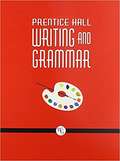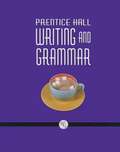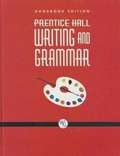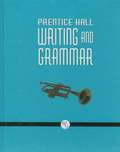- Table View
- List View
Prentice Hall Writing Coach: Writing and Grammar for the 21st Century [Grade 9]
by Jeff Anderson Kelly GallagherNIMAC-sourced textbook
Prentice Hall Writing and Grammar Grade Eleven Handbook Edition
by Edward Wilson Joyce CarollNIMAC-sourced textbook
Prentice Hall Writing and Grammar [Grade 10]
by Edward Wilson Joyce CarollPrentice Hall Writing and Grammar uses real-world connections to develop writing, grammar, and communications skills for Grade 10.
Prentice Hall Writing and Grammar [Grade 9]
by Edward O. Wilson Joyce Armstrong Carroll Gary ForliniGrade 9 Textbook.
Prentice Hall Writing and Grammar, Grade Ten (Handbook Edition)
by Joyce Armstrong Carroll Gary Forlini Edward E. WilsonWriting is already and will continue to be an important part of your everyday life. The writing you do can be as simple as jotting down a phone message or writing yourself a quick reminder or as complex as developing a research paper on a historical event or preparing a science lab report.
Prentice Hall Writing and Grammar, Grade Twelve
by Joyce Armstrong Carroll Gary Forlini Edward E. Wilson Prentice-Hall StaffPrentice Hall Writing and Grammar develops and reinforces skills through an easy-to-follow, three-part chapter organization: Writing--Guided writing instruction walks students through each step of the writing process. Grammar, Usage, and Mechanics--Comprehensive instruction, practice, and application ensure skills mastery. Academic and Workplace Skills--Help students develop test-taking skills, as well as real-world workplace competencies.
Prentice Hall Writing and Grammar: Communication in Action (Gold Level 9, Texas edition)
by Joyce Armstrong CarrolThe TAAS English Language Arts test is not a test on specific reading selections you have studied in the classroom. Rather, it measures your skills in general: comprehension and analysis skills, grammar skills, proofreading skills, and writing skills.
Prentice Hall Writing and Grammar: Communication in Action (Grade 10, Platinum Level, Texas edition)
by Prentice HallThe EOC and TAAS English Language Arts are not tests on specific reading selections you have studied in the classroom. Rather, these tests measure your skills in general: comprehension and analysis skills, grammar skills, proofreading skills, and writing skills.
Prentice Hall Writing and Grammar: Communication in Action, Grade 7 (Handbook Edition)
by Joyce Armstrong Carroll Gary Forlini Edward E. WilsonPrentice Hall Writing and Grammar develops and reinforces skills through an easy-to-follow, three-part chapter organization: Writing--Guided writing instruction walks students through each step of the writing process. Grammar, Usage, and Mechanics--Comprehensive instruction, practice, and application ensure skills mastery. Academic and Workplace Skills--Help students develop test-taking skills, as well as real-world workplace competencies.
Prentice Hall Writing and Grammar: Copper Level
by Joyce Armstrong Carroll Gary Forlini Edward E. WilsonThe "Prentice Hall Writing and Grammar: Communication in Action" consists of three parts dealing with Writing, Grammar, Usage, and Mechanics, and Academic and Workplace Skills. The Texas Test Preparation pages are designed to help the students approach the TAAS test with confidence.
Prentice Hall Writing and Grammar: Copper Level (Handbook Edition)
by Joyce Armstrong Carroll Gary Forlini Edward E. WilsonA textbook to learn writing skills and grammar in English.
Prentice Hall, World Geography, Building a Global Perspective
by Celeste Fraser Thomas J. BaerwaldNIMAC-sourced textbook
Prentice Hall: Biology (Tennessee Edition)
by Kenneth R. Miller Joseph S. LevineNIMAC-sourced textbook
Prentice Hall: Chemistry, Tennessee
by Dennis D. Staley Michael S. Matta Edward L. Waterman Anthony C. WilbrahamPrentice Hall Chemistry: Tennessee Student Edition




